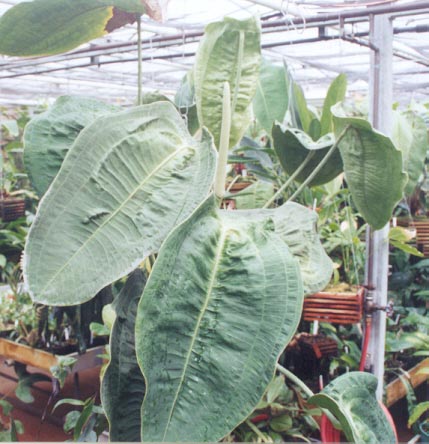Anthurium peltigerum Sodiro, Anales Univ. Centr. Ecuador 19(137): 316. 1905.
Etymology: In reference to the peltate leaf (petiole attaches to the leaf blade entirely within the margin), a rarity in Anthurium.
Distribution: Northwestern Ecuador and Southwestern Columbia, type from Esmereldas, Ecuador near Alto Tambo
Sectional Placement: Anth. peltigerum is a member of section Digitinervium
 |
 |
A beautiful specimen of Anth. peltigerum grown by the folks at
The Atlanta Botanical Garden in their state of the art greenhouses
Description: A. peltigerum sp. nov.; LAM.III caule erecto, robusto; internodiis brevibus; cataphyllis late lanceolatis, mox in fibras rudes resolutis; petiolis subcylindricis, cum geniculo longo, antice breviter sulcatis, quam limbi longioribus; limbis subcoriaceis, supra nigro-subtus pallide glaucescentibus, utrinque nigro-punctatis, circunscriptione ovatis, peltatis, apice acuminatis, latitudine sua 3-plo longioribus, 7-nerviis; nervis lateralibus utrinque 3-ex apice petioli ortis, extimo supra medium limbi, inerioribus in cuspidem limbi cum nervo centrali productis; nervis l.creberrimis, tenuibus, nervum centralem cum laterali proximo, et hunc cum exterioribus vicissim nectentibus; pedunculo quam petiolus 3-4-plo breviore, graciliore; spatha dense papyracea, lanceolata, apice subulato-acuminata, quam spadix sub 2-plo breviore; spadice sessili, cylindrico, rigido, 25-30 cm. longo, 10 mm. crasso, flavescente; tepalis apice cucullatis, deorsum obiter cuneatis.
Description: Stem thick and erect; internodes short; cataphylls lanceolate, drying into persistant fibers; petiole sub-cylindric, sulcate; blade coriacous, glandular punctate and peltate with 3-4 basal veins reaching all the way to the apex and numerous parallel tertiary veins running between the basal veins;
Anthurium peltigerum is a one of the most unusual anthuriums due to it's peltate leaf (one of only 3 species). the numerous basal viens with numerous parallel tertiary viens give this species the look of a turtle shell and thus one of the common names of this beautiful plant, the 'turtle shell' anthurium. Clones of this species have been found in Columbia with a red colored spathe, the normal color being green. Growing mainly as an epiphyte, it can sometimes be found growing as a terrestrial.

Sodiro's illustration of Anth. peltigerum
Copyright © 2007 by Neil Carroll. All rights reserved.